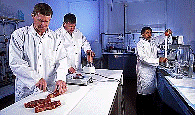United States Department of Agriculture: Agricultural Research Service, Lincoln, Nebraska

Roman L. Hruska U.S. Meat Animal Research Center: Reports
Date of this Version
2013
Document Type
Article
Citation
J. Anim. Sci. 2013.91:4168–4179 doi:10.2527/jas2012-5877
Abstract
Programs for developing replacement heifers are designed for heifers to calve at 2 yr of age and to extend their stayability in the herd and minimize feed cost. The experimental objective was to determine whether developing prepubertal heifers on less dietary energy and to a BW of 55% rather than 65% of mature BW at 14 mo of age would compromise ovarian development and reduce fertility. In a 3-yr study, 8-mo-old Angus (n = 60/yr) and composite U.S. Meat Animal Research Center II (n = 60/yr) heifers were assigned equally by age, BW, and breed to receive either a low (LG) or high (HG) BW gain diet fed to achieve an ADG of either 0.45 or 0.8 kg/d from 8 to 15 mo of age, including the first 21 d of breeding, and then transferred to pasture. At 14 mo, heifers were housed with fertile bulls for 47 d. Estrus was monitored for 21 d. within 12 h after detection of estrus, ovarian length and height, preovulatory follicle diam., and antral follicle count (AFC) were measured by transrectal ultrasonography. corpus luteum (CL) volume and plasma progesterone concentration were measured 5 to 15 d after estrus. Data were analyzed by ANOVA with treatment, breed, and year and their 2-way interactions as independent variables. At breeding, HG heifers were heavier than LG heifers (419.9 vs. 361.8 ± 7.5 kg; P < 0.01); ADG for the treatment period was 0.79 vs. 0.47 ± 0.04 kg/d (P < 0.01), respectively. In 2010 and 2011, 97.2% of heifers were cyclic by 21 d of breeding. Size of the ovary, preovulatory follicle, CL, and AFC did not differ between HG and LG, but preovulatory follicle diam. and ovarian length were greater (P ≤ 0.05) for U.S. Meat Animal Research Center II vs. Angus heifers. Progesterone concentrations were less for LG vs. HG heifers (P ≤ 0.02), whereas CL volume was not affected by treatment or breed but was correlated positively with preovulatory follicle size (P < 0.01). Total AFC ranged from 5 to 49 and was correlated positively with ovarian volume but was not associated with fertility. A greater proportion of HG vs. LG heifers conceived within the first 21 d of the breeding period (64.4% vs. 49.2% ± 3.8%, respectively; P < 0.01), but overall pregnancy rate was not affected by treatment (83.0% vs. 77.7% ± 3.1%, respectively; P > 0.10). Pregnancy rate was 10% less (P < 0.01) for Angus vs. U.S. Meat Animal Research Center II heifers. Developing beef heifers at a lesser ADG to a lighter BW (55% vs. 64% of mature BW) at breeding did not influence postweaning ovarian development or AFC or compromise pregnancy rate during the 47-d breeding period.

